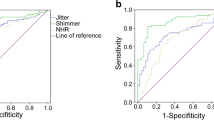Abstract
Acromegaly’s effect on voice is still indefinite. We aimed to define acoustic characteristics of patients with acromegaly. Cross-sectional case–control study was designed. Thirty-seven patients with acromegaly and 30 age- and sex-matched healthy controls were included. Fundamental frequency (F0) and measurements related to frequency, amplitude, noise and tremor of the obtained voice sample were analyzed using Multi-Dimensional Voice Program. Absolute jitter (Jita) and jitter percent (Jitt), shimmer in decibel and shimmer percent, noise to harmonic ratio and soft phonation index, fundamental frequency tremor frequency and frequency tremor intensity index represented the parameters related to frequency, amplitude, noise and tremor of the voice sample, respectively. Patients with acromegaly, especially the uncontrolled patients, exhibited significant differences in frequency perturbation measurements. Jitt of all patients and Jita of uncontrolled patients were significantly higher than that of control group (p = 0.044 and p = 0.043, respectively). Jitter which is a measure of frequency perturbation can be assumed as an indicator of hoarse and deepened voice. Jita of all patients and Jitt of uncontrolled patients were elevated, but not reaching a statistical significance. Controlled and active patients had similar analysis of acoustic parameters. In the correlation analysis, shimmer and IGF-1 (insulin like growth factor 1) was found to be positively correlated in all patients with acromegaly and in female patients. When the p value is adjusted according to Bonferroni correction regarding the use of ten parameters for acoustic analysis (so adjusted p is <0.005), all the statistically significant findings become insignificant. Considering the parameters test different properties of voice, it is reasonable to pay attention to the findings. Patients with acromegaly have increased frequency perturbations measures, but this increase is non-significant according to Bonferroni correction. This may be perceptually sensed as hoarse voice. Amplitude perturbations within the voice of the patients with acromegaly are positively correlated with IGF-1 levels, this correlation is also non-significant according to Bonferroni correction.
Similar content being viewed by others
References
Melmed S (2006) Medical progress: acromegaly. N Engl J Med 355(24):2558–2573. doi:10.1056/NEJMra062453
Weinberg B, Dexter R, Horii Y (1975) Selected speech and fundamental frequency characteristics of patients with acromegaly. J Speech Hear Disord 40(2):253–259
Williams RG, Richards SH, Mills RG, Eccles R (1994) Voice changes in acromegaly. Laryngoscope 104(4):484–487. doi:10.1288/00005537-199404000-00015
Saussez S, Mahillon V, Chantrain G, Thill MP, Lequeux T (2007) Acromegaly presented as a cause of laryngeal dyspnea. Auris Nasus Larynx 34(4):541–543. doi:10.1016/j.anl.2006.11.014
Nachtigall L, Delgado A, Swearingen B, Lee H, Zerikly R, Klibanski A (2008) Changing patterns in diagnosis and therapy of acromegaly over two decades. J Clin Endocrinol Metab 93(6):2035–2041. doi:10.1210/jc.2007-2149
Giustina A, Chanson P, Bronstein MD, Klibanski A, Lamberts S, Casanueva FF, Trainer P, Ghigo E, Ho K, Melmed S (2010) A consensus on criteria for cure of acromegaly. J Clin Endocrinol Metab 95(7):3141–3148. doi:10.1210/jc.2009-2670
Trotman-Dickenson B, Weetman AP, Hughes JM (1991) Upper airflow obstruction and pulmonary function in acromegaly: relationship to disease activity. Q J Med 79(290):527–538
Morewood DJ, Belchetz PE, Evans CC, Whitehouse GH (1986) The extrathoracic airway in acromegaly. Clin Radiol 37(3):243–246 pii: S0009-9260(86)80327-0
Bogazzi F, Nacci A, Campomori A, La Vela R, Rossi G, Lombardi M, Fattori B, Bartalena L, Ursino F, Martino E (2010) Analysis of voice in patients with untreated active acromegaly. J Endocrinol Invest 33(3):178–185 pii: 6985
Brockmann-Bauser M, Drinnan MJ (2011) Routine acoustic voice analysis: time to think again? Curr Opin Otolaryngol Head Neck Surg 19(3):165–170. doi:10.1097/MOO.0b013e32834575fe
Oguz H, Tarhan E, Korkmaz M, Yilmaz U, Safak MA, Demirci M, Ozluoglu LN (2007) Acoustic analysis findings in objective laryngopharyngeal reflux patients. J Voice 21(2):203–210. doi:10.1016/j.jvoice.2005.10.005
Yumoto E, Gould WJ, Baer T (1982) Harmonics-to-noise ratio as an index of the degree of hoarseness. J Acoust Soc Am 71(6):1544–1549
Conflict of interest
The authors have no funding, financial relationships, or conflicts of interest to disclose.
Author information
Authors and Affiliations
Corresponding author
Rights and permissions
About this article
Cite this article
Aydin, K., Turkyilmaz, D., Ozturk, B. et al. Voice characteristics of acromegaly. Eur Arch Otorhinolaryngol 270, 1391–1396 (2013). https://doi.org/10.1007/s00405-013-2369-4
Received:
Accepted:
Published:
Issue Date:
DOI: https://doi.org/10.1007/s00405-013-2369-4




